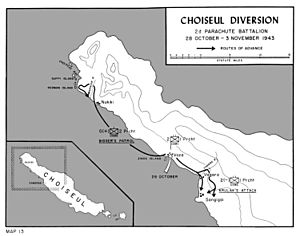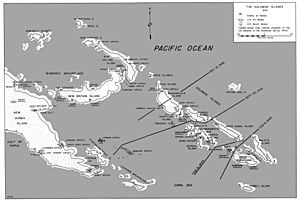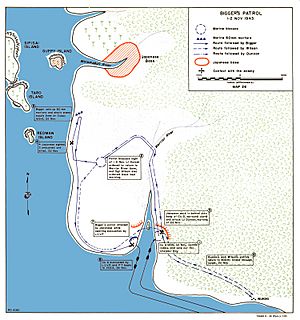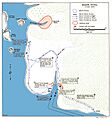Raid on Choiseul facts for kids
Quick facts for kids Raid on Choiseul |
|||||||
|---|---|---|---|---|---|---|---|
| Part of the Pacific Theater of World War II | |||||||
 A map of the raid on Choiseul |
|||||||
|
|||||||
| Belligerents | |||||||
| Commanders and leaders | |||||||
| Strength | |||||||
| 656–725 | 3,000–7,000 | ||||||
| Casualties and losses | |||||||
| 11–13 killed, 15 wounded |
143 killed, two barges sunk |
||||||
The Raid on Choiseul (also called Operation Blissful) was a small military action. It happened from October 28 to November 3, 1943. This raid was part of the Solomon Islands campaign during World War II.
The main goal of the raid was to trick the Japanese. The Allied forces wanted to land troops on Bougainville Island. They hoped the raid would make the Japanese think the main attack was somewhere else.
United States Marines from the 2nd Parachute Battalion took part. They landed on Choiseul Island, which the Japanese controlled. The Marines attacked Japanese army and navy forces. They covered an area of about 25 miles over seven days. Local Choiseul islanders and an Australian coastwatcher helped them. After the US troops landed successfully on Bougainville, the Marines left Choiseul. They were taken back to Vella Lavella by boats.
Contents
Why the Raid Happened
Choiseul Island's Role in the War
Choiseul Island is about 45 miles southeast of Bougainville Island. It is also northwest of Santa Isabel. The island is about 75 miles long. Its widest point is about 25 miles across.
Around 5,000 Melanesians lived on the island at the time. Most of them lived along the coast. Before the war, Australia governed the island. But early in the war, the Japanese took control.
Most local people supported the Allies. Two coastwatchers, Charles J. Waddell and Carden Seton, worked there. They gathered information about Japanese ships and troops. This information helped the Allies during the Guadalcanal campaign.
Planning the Diversion
After fighting ended on Guadalcanal, the Allies captured the New Georgia islands. Then, they started planning to move north towards Bougainville. To help with this, they planned some fake attacks. These attacks were meant to distract the Japanese. One such attack was the Battle of the Treasury Islands. The other was the raid on Choiseul.
Allied leaders first thought about making Choiseul their main attack spot. But they later decided to attack the west coast of Bougainville instead. So, the Choiseul operation became a distraction. The Allies hoped it would make the Japanese think the main landings would be on the east side of Bougainville. This would draw Japanese attention away from landings at Cape Torokina.
Scouting the Island
In September 1943, Allied patrols visited Choiseul. These included New Zealanders, US Marines, and US Navy personnel. They spent several days gathering information. They looked at Japanese positions and troop numbers. They also talked to the coastwatchers. They searched for good spots for airfields and landing beaches.
The patrols found that the island's land was not good for dropping troops from the air. So, they decided they needed to land troops from the sea. Coral reefs made most landing spots difficult. Voza, an old village south of Choiseul Bay, was chosen as the best place. Many beaches were narrow, leading to thick jungle. Other areas had cliffs by the sea. The island's inside was thick jungle and mountains. This made moving around very hard. Because of this, Allied planners decided to send only a small force.
In early October, Seton, the coastwatcher, sent more information. He confirmed that the Japanese were using Choiseul. They were moving troops from the central Solomons to Bougainville. He thought there were about 3,000 Japanese troops. They were spread out between Choiseul Bay and Sangigai. He also reported that the Japanese were tired and low on food.
On October 22, the Allies confirmed the operation. They named it Operation Blissful. Commanders met on Guadalcanal for a briefing. Then, they flew to Vella Lavella to plan the raid.
The Raid Begins
Landing at Voza
The raid involved 656 to 725 men. They were from the US 2nd Parachute Battalion. Lieutenant Colonel Victor Krulak led them. On October 27, they boarded eight LCM landing craft at Vella Lavella. Then, they moved to four fast transport ships. These ships had just helped New Zealand troops land on the Treasury Islands.
The Japanese troops on Choiseul numbered between 3,000 and 7,000. Major General Minoru Sasaki was their commander. Most of these troops were near Kakasa and Choiseul Bay. Choiseul Bay had a small harbor for barges.
The US ships, escorted by the destroyer USS Conway, sailed towards Choiseul at night. A Japanese aircraft attacked them on the way. One bomb nearly hit a transport ship. Just before midnight, the ships reached the landing area. It was about 2,000 yards offshore of Voza. A small group went ashore first in rubber boats. Then, Companies F and G led the Marines ashore. They landed without any Japanese resistance early on October 28. During the landing, a Japanese aircraft attacked Conway. The bombs missed. The destroyer did not fire back. This was to keep the landing a secret.
Setting Up the Base
After the landing spot was secure, boats brought supplies and equipment ashore. About 80 local helpers, organized by Seton, helped the Marines. Krulak's battalion set up a strong base on a plateau. It was about 1,000 yards west of Voza. They set up radio communications. They also placed warning posts to the north and south.
From this base, Krulak planned to attack widely. He wanted to make the Japanese think his force was much larger. He planned actions around Sangigai and in the western part of the island. This included areas as far as Nukiki and the Warrior River. This covered about 25 miles.
Soon after landing, Krulak sent a fake radio message. It said he had landed 20,000 men on the island. He said he was about to start operations. Within two hours, all supplies were unloaded. The transport ships and destroyer left for Vella Lavella. Four LCVP landing craft stayed behind. Their crews were to help the Marines move along the coast.
Japanese aircraft attacked the landing beach shortly after the Marines landed. They attacked again later that day and in the evening. They also attacked Zinoa Island, where the Marines had hidden their boats. These attacks did not work. The Marines had quickly spread out their equipment. They also tried to hide their landing spot. They built a fake landing site further north to trick the Japanese.
First Attacks and Patrols
On the afternoon of October 28, Krulak sent a patrol. They were to find a base for PT boats along the western coast. Meanwhile, Seton's local network also sent out patrols. They found the closest Japanese positions. The main group was around Sangigai. Another smaller group was about 30 miles northwest.
On October 29, more patrols went out. They went north and south to find out about Japanese defenses. They also drew maps of important places. Other patrols, with Army and Navy experts, checked Moli Point. They looked for places for PT boat bases or radar stations. One patrol attacked and killed seven Japanese. They also sank a barge near the Vagara River. Later, a blocking force went to Vagara. They fought with a group of Japanese. Krulak then decided to attack the main Japanese position at Sangigai the next day. He wanted to stop any Japanese attack on his base at Voza.
Battle at Sangigai
On October 30, Companies E and F attacked the barge base at Sangigai. Krulak led them. They had support troops with rockets and mortars. They also had a machine-gun section. They left at 4:00 AM. They planned to use landing craft near Zinoa Island to move along the coast.
A preliminary air attack was planned. Twelve Grumman TBF Avenger torpedo bombers were to attack. They were escorted by 26 fighters. But these aircraft mistakenly fired on the US landing craft. One was damaged. Because of this, Krulak's two companies had to walk to their target. Seton and his local guides led them. The airstrike hit Sangigai at 6:10 AM.
Around 11:00 AM, a quick fight happened near Vagara. Japanese guards fired on the Marines. But the Japanese were forced to go back to their main position at Sangigai.
The two Marine companies split up to attack from two sides. Thick jungle and rough land slowed Company F. Krulak was with them. They were moving inland to attack from the side. They were still getting into position when firing started north of the village around 2:00 PM. At this time, Company E, led by Captain Robert E. Manchester, had moved along the coast. They were delayed only a few minutes. They used their mortars and rockets. They shelled a Japanese ridge about 500 yards north of the village. Then, they attacked. They took control of the village a few minutes later.
The Japanese defenders had left Sangigai. They moved inland. There, they ran into fire from Company F. This company was on high ground east of the village. From 2:30 PM, more fighting happened. The Marines tried to surround the Japanese. The Japanese tried several direct attacks. Finally, after about an hour, the 40 Japanese survivors ran away into the jungle.
In this battle, 72 Japanese were killed. The Marines lost four killed and 12 wounded. Krulak was among the wounded. After the fight, the Marines searched the village for information. They destroyed any remaining Japanese equipment. Then, they went back to Vagara. They set up a defensive position for the night. In the morning, the raiding party boarded boats and returned to Voza.
Patrols and Withdrawal Preparations
Throughout October 31 and November 1, the Marines continued patrolling. They expected a Japanese counterattack. Several small fights happened between patrols. The Japanese reoccupied Sangigai. But they did not attack the Marine base at Voza. Wounded Marines were taken away by a Consolidated PBY Catalina flying boat. More supplies were flown in, including food for Seton's local guides.
On November 1, a patrol of 87 Marines from Company G was sent north. Major Warner T. Bigger, the battalion's second-in-command, led them. They went by landing craft towards Nukiki. They landed near the Warrior River. The patrol planned to attack the Japanese near Choiseul Bay with their 60mm mortars. The boats were hidden in a cove near Nukiki. Four men stayed in a base camp with a radio. They were on the east bank of the river with heavy equipment and explosives.
The patrol then set off towards Choiseul Bay. But after crossing the river, their guides got lost. The Marines had to set up camp for the night. A smaller group went back to contact Voza. They asked for another guide.
During the night, a group of Japanese cut off the two Marine groups. But on November 2, the smaller group was able to get back on their boats at Nukiki. They returned to Voza without being seen. The larger group under Bigger continued their mission. They sent several men back to the river to ask for pickup later that afternoon. They came under fire near Redman Island from a small Japanese outpost. This outpost was quickly destroyed. Bigger then decided to attack his backup target. This was the Japanese supply and fuel dump on Guppy Island. From the beach, 143 mortar rounds were fired. This set the base on fire.
As the Marines started to leave, the Japanese landed troops behind them. They tried to cut off their escape. Bigger's force fought off four separate attacks. They set up a position on the west bank of the Warrior River. They waited for the boats to pick them up. At this point, the raid stopped for a moment. A Japanese ambush trapped between 40 and 50 Marines. Three Marines were badly wounded, and one died. Ten Marines were rescued by the motor torpedo boat PT-59. Lieutenant John F. Kennedy commanded this boat. Fire from PT-59 gave the Navy time to rescue many other Marines. They were on another PT boat, PT-236. Air support from planes based on Munda covered them.
After Bigger's force was rescued, the US command thought about pulling Krulak's Marines out of Choiseul. The Japanese realized the US force was small. They started more aggressive patrols towards Vagara. More patrol clashes happened on November 1. Information from Seton and local people showed that the Japanese had gathered 800 to 1,000 men in Sangigai. Other troops were gathering north of the Marine base at Voza. Krulak talked with Seton. He made plans to move across the island if his base was cut off from the beach. But in the end, the US commanders decided to pull the Marines out before that happened.
The Marines left the island on three LCI landing craft. This happened on the morning of November 4. This was after Allied troops successfully landed at Cape Torokina. To cover their leaving, the Marines laid a mine field. They also set other booby traps. As the Marines loaded their supplies, several explosions were heard. Japanese patrols had entered the minefield. After getting on board, the Marines returned to Vella Lavella. Five PT boats, commanded by Lieutenant Arthur H. Berndston, escorted them.
What Happened Next
After the Marine battalion left, the Japanese quickly took back Voza. They wanted to secure the area again for their ongoing evacuation. During the operation, Krulak's battalion killed 143 Japanese troops. They also sank two Japanese barges. The Marines lost between 11 and 13 killed and 15 wounded.
Major General Roy Geiger later described the actions. He called them "a series of short right jabs." These were meant to confuse the enemy. They hid the "real power of the left hook" at Empress Augusta Bay. Historian John Miller says it is unclear how much the raid affected the Japanese response. Japanese records do not clearly show this. But it is unlikely that the "diversion confirmed... [the] belief that southern Bougainville was the main Allied objective." However, John Costello points out that after the raid, the Japanese moved thousands of extra troops to Choiseul.
Information gathered during the raid also helped Allied naval commanders. They found minefields around Cape Torokina. And they could mine areas the Japanese thought were safe. The local Choiseul Islanders were confused when the Marines left. They had helped the Marines. But Seton stayed on Choiseul after the raid. He helped find targets for Allied dive bombers to attack. He left the island in mid-to-late 1944.
Images for kids








